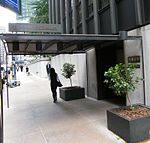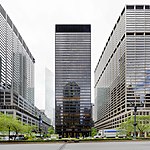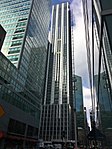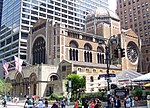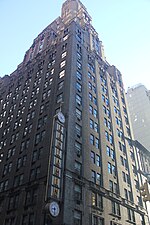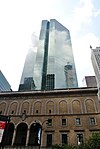345 Park Avenue

345 Park Avenue is a 634-foot (193 m) skyscraper in the Midtown Manhattan neighborhood of New York City. It occupies an entire city block bounded by Park Avenue, Lexington Avenue, 51st Street, and 52nd Street. Completed in 1969, with 44 floors, the building was designed by Emery Roth & Sons. It is near the Racquet and Tennis Club and Park Avenue Plaza to the northeast; the Seagram Building to the north; 599 Lexington Avenue to the northeast; and St. Bartholomew's Episcopal Church and the General Electric Building to the south. It is built on the site of the Hotel Ambassador, which had opened in 1921. It was sold to Sheraton Hotels in 1958 and renamed the Sheraton-East. It was demolished in 1966. Exteriors of 345 Park Avenue were used as the headquarters of CSC and Continental Corp. in the Aaron Sorkin series Sports Night from 1998 to 2000.
Excerpt from the Wikipedia article 345 Park Avenue (License: CC BY-SA 3.0, Authors, Images).345 Park Avenue
Park Avenue, New York Manhattan
Geographical coordinates (GPS) Address External links Nearby Places Show on map
Geographical coordinates (GPS)
| Latitude | Longitude |
|---|---|
| N 40.7578 ° | E -73.9725 ° |
Address
345 Park Avenue
Park Avenue 345
10154 New York, Manhattan
New York, United States
Open on Google Maps

